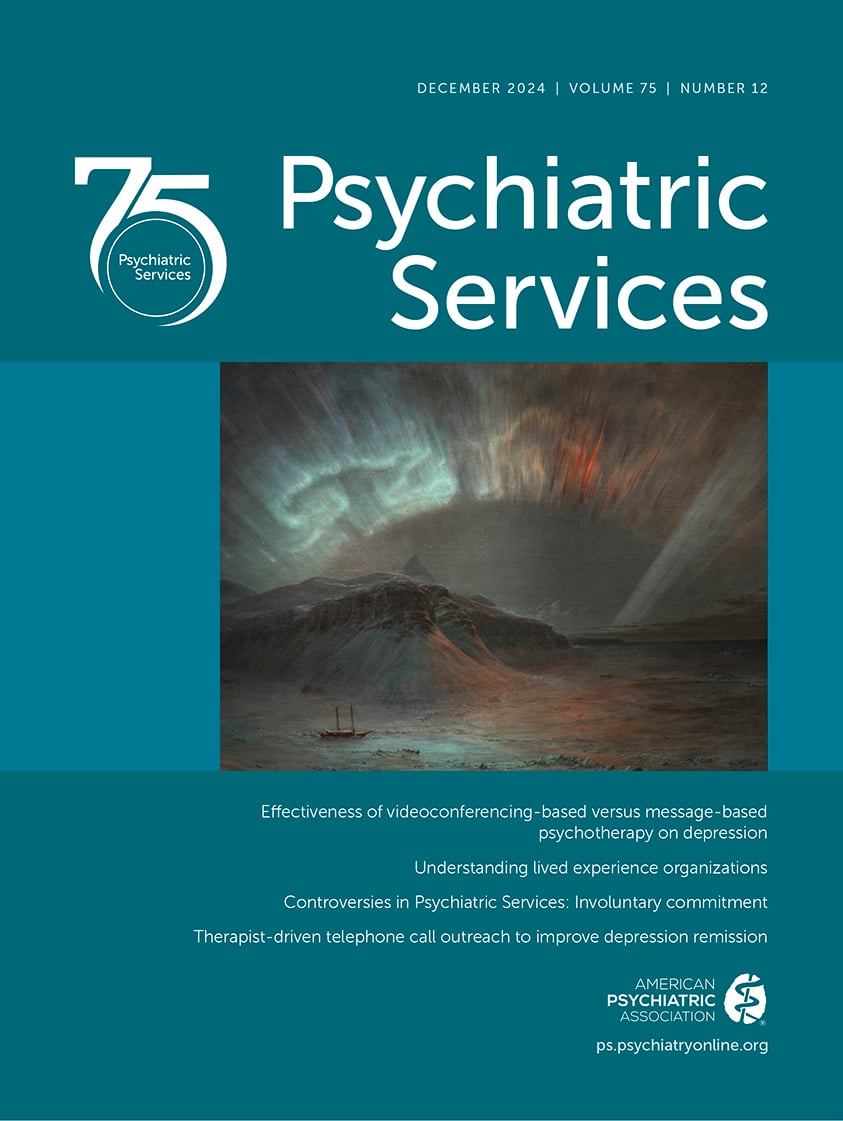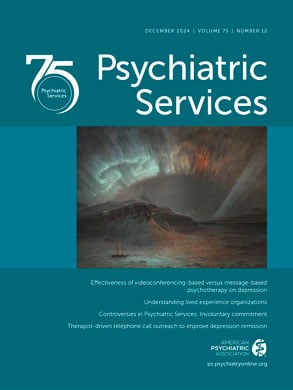I have spent the past 22 years as a forensic patient in New South Wales, Australia. Although it has been a difficult journey, once I found the right support, I learned that even when life is at its darkest, hope makes all the difference.
A forensic patient is a person who has been found not guilty in court because of mental illness or mental impairment (
1). In 2022, there were 485 forensic patients in New South Wales, an increase of 3.4% from the previous year (
2). The forensic system is best described as a partnership between the justice system and the mental health system. Being remanded to the forensic system is not a “get out of jail free” card; rather, it is a place to serve an indefinite sentence that carries no guarantee of release. In my personal experience, I have seen forensic patients commonly spend over a decade in various secure mental health units as they gradually transition back to public life. Although the patient’s recovery and rehabilitation are high priorities, the safety of the community is always the number one concern.
After experiencing poor mental health throughout my childhood, I had a psychotic episode at 18 years of age and became a forensic patient at 19. My road to prison was paved by loss—not just of my freedom but also of my family, friends, home, possessions, well-being, and sanity. Although I struggled with my mental health for the first few years in prison, I had a pretty good idea of what my future held, and I often felt suicidal. I eventually adjusted to my new environment, though, and life went on.
My 4 years in maximum security were quite the experience. Because I was slim and blond and looked about 16 years old, I got a lot of unwanted attention. I am grateful for the inmates who extended their protection to me; thanks to them, the other inmates treated me mostly well. However, just like in communities outside of prison, having a mental health issue in prison carries a stigma. Little respect is shown to “spinners,” and having psychiatric problems around the wrong inmates may invite violence. This is why inmates in mainstream prison populations are reluctant to let anyone know they have a mental health issue.
My incarceration journey started at Long Bay Correctional Complex in D Ward, Long Bay Hospital’s infamous acute unit, which was aptly nicknamed “the Dungeon.” Each of its single-prisoner cells contained a bare plastic mattress on a concrete slab, a fire blanket, a metal sink, and a metal toilet with no lid. Inmates often had nothing in their cells beyond a paperback and the underpants they were wearing. I was unfortunate enough to get a cell without a toilet, so I was given a plastic bucket to use until a better-equipped cell became available. I experienced all kinds of little degradations, such as having my shoelaces snipped down to stubs because of safety regulations, picking my prison greens from a communal pile, and enduring strip searches at dawn.
D Ward had no activities or distractions: all of us stuck there could only smoke White Ox tobacco and talk crap while we waited for the next coffee trolley or horrible meal. Most patients there had serious mental health issues, so things could turn chaotic fast. The Dungeon was by no means a place of recovery and rehabilitation.
Even though I eventually transitioned to a better ward, the routine was tedious. I would wake up to a guard yelling at me, then move back and forth between the prison yard, the dining room, and the common area until it was time to be locked in my cell again for the night. Although the hours were agonizingly boring, the lack of stimuli meant there was little to remember, so the months somehow went by quicker than the days did.
The new forensic hospital next to Long Bay was built after the Dungeon and the other old hospital wards were demolished—and good riddance! This new hospital is separate from the prison and staffed by Justice Health nurses instead of guards. When I was there, we inmates wore civilian clothes, were served edible food, and were treated like humans. The forensic hospital also has facilities where inmates can exercise or study. The environment is good for recovery; compared with the Dungeon, it is a paradise.
A handful of medium-security units across New South Wales house forensic patients. Unfortunately, the supply of available beds is never sufficient, and this bottleneck prevents otherwise well people from moving through the system.
Statistically, forensic patients are very different from mainstream inmates. For instance, according to Wu and colleagues (
3), 6.3% of forensic patients reoffend at some point after their release, compared with the 40% reoffending rate of mainstream inmates. That is an enormous difference!
Although our reoffending rate is very low, many of us forensic patients will go around and around on the carousel of prison and hospital if we experience recurring mental health issues or break the strict conditions we must live by, with penalties for noncompliance varying widely. For example, returning from leave late may result in a week in an open ward, whereas failing a urine drug screen could lead to 3 years in a maximum-security unit. I often felt anxious and like I was living on borrowed time, knowing my life could be reset to zero so easily.
The Mental Health Review Tribunal is a three-person panel that forensic patients see every 6–12 months. The tribunal decides where to transfer patients and what type of leave patients can access. Experts at the top of their fields—such as supreme court judges, king’s counselors, and psychiatrists—serve as tribunal members. Yet, for many years, everything the tribunal approved needed a state-level government minister’s signature, which made the enactment of tribunal decisions glacially slow. In one instance, the tribunal recommended that a patient be transferred from a maximum-security unit to a medium-security unit, but the recommendation was ultimately denied (after 2 years) because it never received a minister’s signature. One can only imagine how hopeless and lost the patient must have felt. It is fortunate that the tribunal no longer needs a minister to approve its decisions, and those decisions are usually shared on the day they are made.
I was just 19 years old when I attended my first tribunal. I remember feeling almost physically sick, sitting in a room full of powerful people in expensive suits who held my future in their hands. Since then, I have experienced over 35 tribunals, and because I have been racking up achievements in every area of my life for a decade, I now look forward to sharing my latest accomplishments with the presiding tribunal members.
Leaving the hospital to live in the community is considered conditional release. Patients granted conditional release, however, continue to be reviewed by the tribunal and must abide by the conditions of their release, such as attending psychiatrist appointments. Although conditional release is exhilarating, a patient’s ultimate goal is to be granted unconditional release—that is, to be discharged from the forensic system and no longer be a forensic patient. In the past, unconditional release was considered by many forensic patients to be almost a myth. Indeed, in a study of forensic patients in New South Wales, Hayes and colleagues found that only 85 patients (of a total of 364 forensic patients) were unconditionally released between January 1990 and December 2010 (
4).
This brings me to the topics I really want to discuss: the power of success stories and the importance of sharing hope and determination in recovery. When forensic patients are granted unconditional release, they move on to better lives, and the forensic patients who are still in the hospital or prison do not hear from them again. However, if these success stories are used to prove that putting in the hard work required to achieve rehabilitation and recovery can result in unconditional release, forensic patients might be inspired to do their best, increasing their odds of earning their own release from incarceration and becoming contributing members of society outside of prison. This transfer of hope could be achieved through a mentor program. Had I known how many forensic patients have successfully transitioned to life outside the forensic hospital, my journey would have been fueled by much more hope. To share that hope that I wish I had been given, my wife and I, since our successful transition to conditional release from Cumberland Hospital, have continued to visit the hospital chapel to offer support to forensic patients who have yet to return to the community. We have met some of our best friends there. We often get together for dinners, movie nights, and birthdays, and we even celebrate Christmas with them.
I have learned that rebuilding a life after spending time in the forensic system is possible, no matter how daunting the task may seem. At the age of 41, I am living in my own home in the community, have married the woman of my dreams, and have left the Disability Support Pension behind. I have held gainful employment writing for Flourish Australia’s mental health recovery publication, Panorama Magazine, for 12 years. My success is attributable to the time, love, and encouragement many have shared with me.
Different things work for different recovery journeys, but in my case, writing was the key. It was my escape from prison, so to speak. Writing is one of the few things I was good at in high school, so building on this strength has been fantastic for my mental health. I penned a couple of novels in prison, which I transcribed on a computer that was little more than a glorified typewriter. I had to hide my floppy disks, because they were contraband and would be destroyed on sight. I successfully smuggled the disks out of prison when I was transferred to a medium-security unit.
Writing has become my career. In addition to working for Panorama Magazine, I helped to create the Recovery Assessment Scale—Domains and Stages: Workbook a few years ago with a team of occupational therapists from the University of Sydney. I have also had my science fiction comedy trilogy, Scum of the Universe, published by Black Cockie Press. The creative potential of science fiction comedy is unlimited, and it is easy to be witty when you have a fortnight to think of a comeback.
So what do I want readers to take away from all this? I believe we can all play a positive role in other people’s recoveries. Indeed, I have seen many forensic patients flourish with the right support. If forensic patients are encouraged by the success stories of people who have been in their same position and achieved unconditional release, then it is truly important to share the message that all forensic patients have the potential to leave the forensic system to become contributing members of society, free to make their way in the world just like anyone else. And isn’t that what we all want from life?

